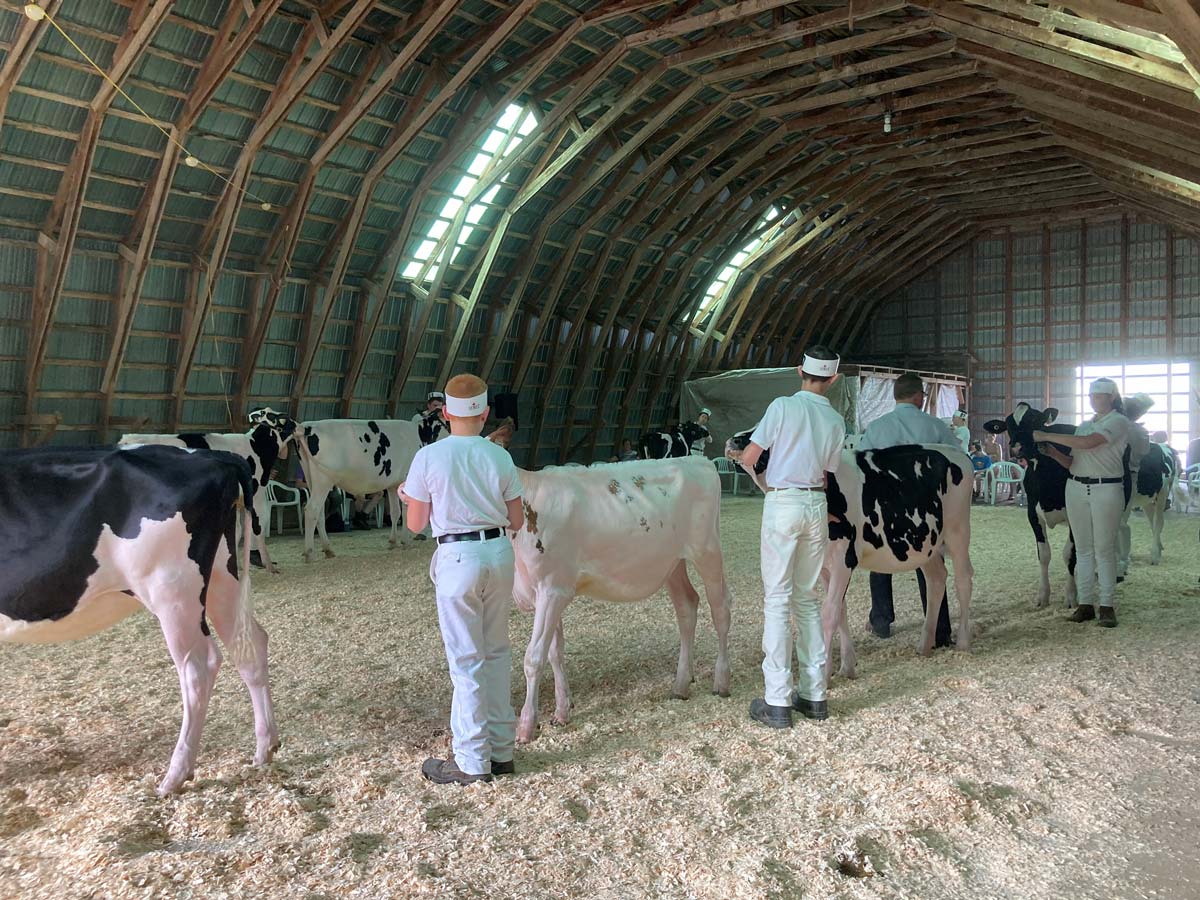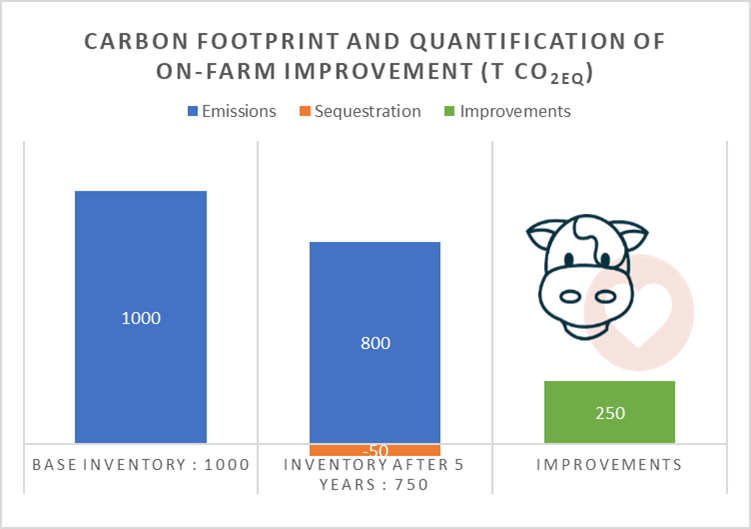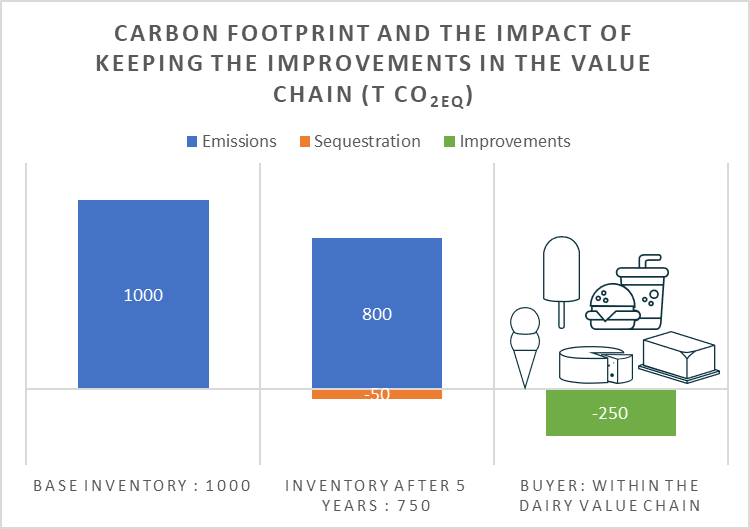Carbon Footprint: What Can be Done With Improvements Once They’re Calculated?

Sustainability continues to be an essential element in dairy production. As a processor, the Cooperative’s commitment is strong, and it provides its members with the tools necessary to make a tangible impact on reducing greenhouse gas (GHG) emissions.
In the last edition of The Milk Box, we discussed what a carbon footprint is and how improvements are calculated, using the example of the fictional Dubon Lait Farm. It had a baseline footprint of 1000 tonnes of CO2 equivalent. After making various improvements over a five-year period, the farm’s emissions were reduced by 200 tonnes, and 50 tonnes of carbon were sequestered. Therefore, the calculation of its footprint after these efforts were put in place shows a reduction in the farm’s carbon footprint of 250 tonnes.
As the level of the farm’s emissions diminishes, the milk it produces has a lower carbon load. In this way, the value chain of all dairy products improves and ultimately helps the dairy industry achieve net-zero emissions by 2050.
Carbon Markets
There are two types of carbon markets: the voluntary market and the compliance market. The type of market will differ according to whether the units are used to meet voluntary emission limits or to comply with regulations.
Emissions reductions on the farm can be recognized as “carbon credits.” According to the definition of Environment and Climate Change Canada, a carbon credit is a “tradeable unit that represents one tonne of reduced GHG emissions or GHGs removed from the atmosphere.” If it has been measured and recognized, the carbon credit may constitute an asset for the farm. Dubon Lait Farm may decide to sell the carbon credits generated on the voluntary or compliance markets outside of the dairy value chain, a tactic commonly known as offsetting. On the compliance market, credits can be purchased by emitters (e.g., transportation, manufacturing companies, or the oil industry, etc.), which have imposed limits.
“It’s important to know that accessing the compliance market is a highly structured process,” explains Etienne Dupont, Agropur’s Sustainable Agriculture Advisor. “You have to stay one step ahead of the game because a project plan must be completed before any change can be made.” In this scenario, the producer must go through audit and brokerage firms to access the compliance market. The brokerage fees can be as high as 25% of the sale amount.
As illustrated in the image above, the transaction has a negative effect on the farm’s carbon footprint because the same carbon credit can’t be counted twice. “The buyer’s carbon footprint improves, but the farm’s footprint goes back to what it was at baseline,” explains Dupont, who compares it with accounting logic. “The credit is used by another industry to reduce its own carbon footprint, therefore the footprint of the dairy farm won’t improve.”
A farm making the decision to sell its credits to a buyer outside of the dairy value chain sees its carbon footprint return to the previous measurement. In our example, Dubon Lait sees its footprint go back to 1000 tonnes, despite the efforts it has made. The milk produced by the farm is no longer considered as being a lower carbon load. That makes it harder to reach the GHG reduction objectives of dairy producers, dairy processors, and their customers.
Another Scenario on the Horizon
Looking internationally, there’s another option (still only theoretical for the Canadian dairy sector) called insetting. What’s unique about this market is that the Dubon Lait Farm’s certified improvements will remain in the dairy value chain because the buyer is part of the industry, such as a dairy processor or dairy product retailer (see the image above). The processor can then offer products with a lower carbon load to its clients and meet its market expectations. However, there is still no such market for milk in Canada and so far, it’s not clear when the option will be available.
Determining the Right Time
The Dubon Lait Farm took a big step that will help it be more efficient and better adapt to climate change. Each dairy farm can now ask itself the question: when do we decide to commit to measuring our environmental footprint?
“Once the initial measurement of the carbon footprint has been made, every new improvement can have an impact on the company’s footprint,” adds Dupont. “Becoming a sustainable farm is a process of continuous improvement, and it’s imperative for the dairy industry as a whole that the results of these efforts are quantified.”
If you’re a member and want to continue your sustainability journey, you can now complete the form available at this link or contact your Cooperative Advisor whose contact information is available on your Agropur’s Milk Pay Statement, your Capital Statement
and the Members’ Extranet.
YOUR COOPERATIVE
Agropur, Very Much Involved in its Community
Giving back to communities has been part of Agropur’s DNA for over 85 years. Here we introduce some examples of your cooperative’s involvement.







